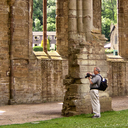0 Likes
Description
San Pedro de Nora: Plan according to Manzanares Indeed, located in a beautiful spot near the Nora river, its appearance is that of an attractive rural version of San Julián de los Prados, although more stylized due to a greater length/width ratio. Its plan is of the basilica type with three naves and three apses, forming a trapezoid 18m long, 13m wide on the main façade and 12m at the head, which is flat with three apses and a rectangular window in each apse. In addition to these three windows, lintels with a brick relief arch and protected by a lattice, on the top floor of the apse there is another trifora window over a chamber that, similar to Santullano, exists above the central apse and that, as in that one, does not offer any communication with the interior of the church either. Following the same model, it also has buttresses, although in this case only in the separation of the apses and on the sides of the chancel.
San Pedro de Nora: Head and south sideAt the foot there is a rectangular portico, somewhat narrower than the central nave, rebuilt in the restoration according to the remains that were preserved. It is considered possible that this portico originally had two side chambers, although no evidence has been found in the excavations and its similarity to Santullano, which has a single central portico, makes it unlikely. However, remains of compartments attached to the side naves have been found, the shape and use of which is unknown, although it has been verified that they were two-storied. In the reconstruction, a bell tower was added, possibly inspired by the existing one in Santa María de Bendones, but of which no remains have been found that suggest that there was another similar one in San Pedro de Nora.
San Pedro de Nora: View of the west façade with the new portico The church is built of small stone masonry with ashlars in the corners, and a flat roof in the three naves, which are separated by four semicircular brick arches , somewhat stilted, on square pillars with bases and molded imposts, the width of the central nave being slightly more than double that of the lateral ones. The three apses, narrower than the naves due to the great thickness of the walls that separate them, are covered by barrel vaults and connected to each other, with access from the naves also through semicircular brick arches. Its resemblance to Santullano is evident, although in this case, as it is a church of much lesser importance, so the existence of a royal tribune in the clergy area would not be mandatory, there is no large transept nave found in the basilica of Oviedo, so the structure of San Pedro de Nora, despite its trapezoidal shape, retains a greater resemblance to a classical basilica.
San Pedro de Nora: Interior view of the apse and the central naveIn the interior, which preserves some remains of the original paintings on stucco, the visual effect generated by the slight narrowing that occurs in the church from the foot to the head and that accentuates the sensation of depth. It has adequate lighting for the naves, provided by three good-sized rectangular windows on each side of the central nave, above the roof of the lateral ones, which in this case are not centered on the arches as in Santullano, and by a large open window above the portico on the west façade. As we have already indicated, the apse also has its own lighting through a good-sized rectangular window in the front of each apse. The good lighting, added to the great height of the central nave – 11m – and the aforementioned visual effect, provides a vision of the interior with a very balanced and attractive aesthetic.
conclusions
Despite its humble proportions and its simple structure, San Pedro de Nora is a good example of Asturian Pre-Romanesque Art and thanks to a careful reconstruction, its interesting parallelism with Santullano and the charm of the place in which it is located, we recommend your visit any type of traveler
https://www.turismo-prerromanico.com/monumento/san-pedro-de-nora-20130115183122/
Esta imagen no sería posible sin la colaboración de la Consejería de Cultura, Política Llingüística y Turismo, Gobierno del Principado de Asturias, España.
...




